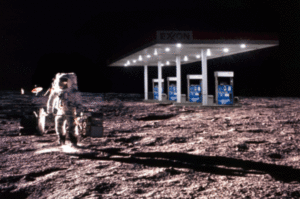Public Relations to Infinity and Beyond!
Published on April 4, 2018, at 4:09 p.m.
by Skylar Spencer.
Throughout the rise of the public relations profession, the sky has been the limit. PR professionals have conquered each and every challenge that has risen, and in doing so, have skillfully mastered the art of adaptation. From Edward Bernays’ concept of a “two-way street” to the age of digital media, the profession evolved to embrace the emerging trends, and thus, adapt to them. But all of these outside forces have been within our reach, within our reason, within our comfort zone (at least to a certain extent) — until now.
New industries and technologies have been the center of discussion, and this theme is slowly but surely redefining our limitations as a society. The sky is no longer the limit; our new and emerging limit is (ironically) limitless, because it exists in outer space. Our wildest fantasies may just become reality — from hypersonic space travel to turning the moon into a gas station — as a result of outer space tech, forcing us to stop and rethink traditional industries.

So, how must we adapt to this new challenge that’s literally out of our reach? Ogilvy & Mather and its disciples have already started to answer this question, and perhaps the communications industry as a whole should follow in its footsteps.
Say it with me: To infinity and beyond!
When moving to infinity and beyond, how can we effectively leverage public relations in outer space? Well, one thing is clear — the PR possibilities are endless.

Ben Levine, an account director at Ogilvy & Mather New York, explores the soon-to-be consumer facing industry in a recent article, “The final frontier: reimagining marketing and communications in outer space.”
Levine questions, “How might we galvanize a new generation of entrepreneurs, professionals, scientists, investors and average consumers to understand the opportunities that the outer space industry can bring? What does the ‘brand’ of outer space look like? How do we help companies capitalize on this new, exciting and misunderstood place to do business?”
Levine isn’t the only futurist at Ogilvy & Mather. In fact, an earlier Adweek article explains how Ogilvy developed a pro-bono partnership with the New York Space Alliance, where the agency created a new visual identity, online presence and print campaign for the organization.
This is where PR pros can use their storytelling abilities to shine. The science and technology industry is overflowing with complicated jargon, unconsciously creating a disconnect between itself and publics outside its industry. If we view space as its own brand, who better to break it down and effectively communicate outer space and its happenings than the comm-masters themselves?
Consider the challenges.
With new possibilities come new challenges, one being transparency. I can’t help but question outer space in the broader perspective of government relations and classified information. So, how can we practice public relations when transparency isn’t an option?
There’s been much skepticism with government space exploration and to what extent information is being disclosed to the public. To manage current and future activities in the use of outer space, appropriate legal rules will undoubtedly be established. As a result, communicators will have to develop ethical strategies for such situations that don’t break the governing law, but do maintain the honest relationship with an organization’s key publics.

Remaining transparent goes hand in hand with another potential obstacle as we sail into the final frontier: safety. If space tourism erupts as Elon Musk envisions, civilians like you and me will have the opportunity to leave our delicate atmosphere and experience the wonders of the galaxy. The harsh reality? Space is dangerous and unpredictable, creating a recipe for crises.
We shouldn’t shy away from these obstacles, however. Instead, and as Levine candidly put it, we must “make ourselves feel uncomfortable,” because uncomfortable is good — it empowers us to learn new skills and ignites change in the way our profession operates. And let’s face it … what better way to stay one step ahead than reaching for the stars?




